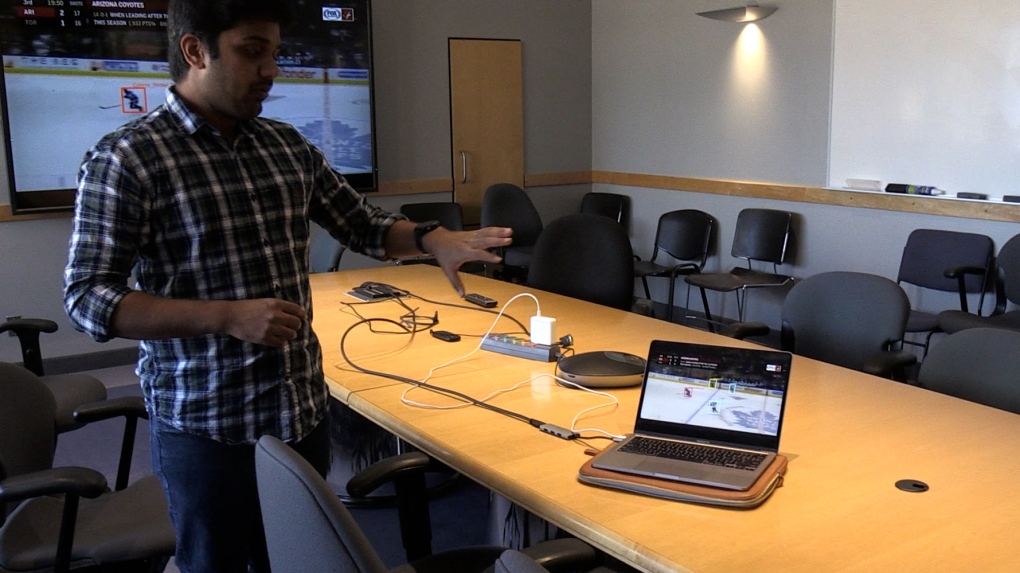University of Waterloo using AI to analyze hockey decisions on the ice
Researchers at the University of Waterloo are using artificial intelligence to analyze hockey players and better understand the decisions they make on the ice.
“Essentially, picking patterns in video,” explained John Zelek, an associate professor in UW’s department of systems design engineering. “The patterns have to be the players moving and how they're interacting.”
The researchers have partnered with Stathletes, a professional hockey performance data and analytics company in St. Catharines, Ont., to automate the process of tracking players. They use clips from the main camera view of an NHL broadcast and then apply the AI technology. Unlike more common tracking systems, the AI can analyze a player’s movement on the ice and indicate the direction they’re facing.
“To understand, not what players are doing, but what are they doing relative to each other. Then that starts feeding into strategy and outcomes,” said David Clausi, another professor in UW’s department of systems design engineering.
Stathletes started using the technology in house, but the researchers said creating the tool hasn’t been easy.
“They have this highly non-linear rapid motion. For example, shifts in ice hockey happened without any notice at all. These are really challenging, yet very ripe grounds for computer vision,” said UW masters student Harish Prakash.
 Harish Prakash, a masters student at the University of Waterloo, explains how artificial intelligence is being used to analyze hockey. (Colton Wiens/CTV Kitchener)
Harish Prakash, a masters student at the University of Waterloo, explains how artificial intelligence is being used to analyze hockey. (Colton Wiens/CTV Kitchener)
The equipment used in the game also presents a challenge.
“The bloody sticks,” explained UW masters student Bavesh Balaji.
Researchers had to teach the AI to track how players are holding their stick in order to understand their technique.
“I had to do a lot of workarounds and I had to find a lot of algorithms,” Balaji said.
A challenge researcher’s face going forward is how to teach the AI to track the puck during a game.
“Its things humans take for granted in the game, like knowing where the puck is innately, is something that's very difficult to teach an algorithm to do,” Clausi explained.
In the NHL, infrared technology combines with up to 20 cameras to capture data from trackers inside the pucks and every jersey. The researchers said their technology requires less equipment and can be used across different hockey leagues. It can also be applied to other sports or even outside of athletics, like helping robots work together in the future.
“We can think about which robot is essentially helping the other properly or improperly and how can we accomplish a task more efficiently,” said Sirisha Rambhatla, an assistant professor in the department of managing science and engineering at the University of Waterloo.
CTVNews.ca Top Stories

opinion Tom Mulcair: Prime Minister Justin Trudeau's train wreck of a final act
In his latest column for CTVNews.ca, former NDP leader and political analyst Tom Mulcair puts a spotlight on the 'spectacular failure' of Prime Minister Justin Trudeau's final act on the political stage.
B.C. mayor gets calls from across Canada about 'crazy' plan to recruit doctors
A British Columbia community's "out-of-the-box" plan to ease its family doctor shortage by hiring physicians as city employees is sparking interest from across Canada, says Colwood Mayor Doug Kobayashi.
'There’s no support': Domestic abuse survivor shares difficulties leaving her relationship
An Edmonton woman who tried to flee an abusive relationship ended up back where she started in part due to a lack of shelter space.
opinion King Charles' Christmas: Who's in and who's out this year?
Christmas 2024 is set to be a Christmas like no other for the Royal Family, says royal commentator Afua Hagan. King Charles III has initiated the most important and significant transformation of royal Christmas celebrations in decades.
Baseball Hall of Famer Rickey Henderson dead at 65, reports say
Rickey Henderson, a Baseball Hall of Famer and Major League Baseball’s all-time stolen bases leader, is dead at 65, according to multiple reports.
Arizona third-grader saves choking friend
An Arizona third-grader is being recognized by his local fire department after saving a friend from choking.
Germans mourn the 5 killed and 200 injured in the apparent attack on a Christmas market
Germans on Saturday mourned the victims of an apparent attack in which authorities say a doctor drove into a busy outdoor Christmas market, killing five people, injuring 200 others and shaking the public’s sense of security at what would otherwise be a time of joy.
Blake Lively accuses 'It Ends With Us' director Justin Baldoni of harassment and smear campaign
Blake Lively has accused her 'It Ends With Us' director and co-star Justin Baldoni of sexual harassment on the set of the movie and a subsequent effort to “destroy' her reputation in a legal complaint.
Oysters distributed in B.C., Alberta, Ontario recalled for norovirus contamination
The Canadian Food Inspection Agency has issued a recall due to possible norovirus contamination of certain oysters distributed in British Columbia, Alberta and Ontario.


































